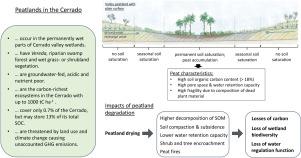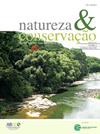“Peatlands in the Brazilian Cerrado: insights into knowledge, status and research needs”
IF 3.5
2区 环境科学与生态学
Q1 BIODIVERSITY CONSERVATION
引用次数: 0
Abstract
Wetlands play an important role for water, carbon storage and biodiversity in the seasonally dry and hot environments of tropical savannas. Peatlands, which are permanent wetlands, are important as the carbon-richest parts of wetland ecosystems with a strong ability to store carbon, retain water and regulate its flow. With this first review on peatlands in the Cerrado we synthesize existing knowledge and gaps on their distribution and types in the biome including, vegetation, soil properties, carbon stocks and hydrogeomorphology. Peatlands are embedded in wetland complexes in valleys, groundwater-fed oligo- to mesotrophic, with wet grass- and shrubland, Vereda or riparian swamp forest vegetation. Average peat depth is 1.4 meters and soil carbon stocks in the first meter can be 9 times higher than in mineral soils under Cerrado dryland vegetation, reaching about 1000 t carbon per hectare. Total soil carbon stock estimates (3.19 Gt C) in peatlands equal 13.3% of the total soil carbon in the Cerrado in only 0.7% of its total area, although large uncertainties exist. Actual peatland occurrence appears to be more abundant than current soil and peat maps suggest. The high rate of transformation of the native vegetation into industrial agriculture and wood plantations, which affects large parts of the Cerrado, is a major cause for the degradation and the loss of peatlands and other wetlands. However, the extent of peatland degradation and resulting carbon losses remain unfathomed. We identified research needs such as better mapping and monitoring, and recommend including peatlands into wetland classification systems in Brazil.

"巴西塞拉多地区的泥炭地:对知识、现状和研究需求的见解"
在热带稀树草原季节性干旱和炎热的环境中,湿地在水源、碳储存和生物多样性方面发挥着重要作用。泥炭地是永久性湿地,是湿地生态系统中碳含量最高的部分,具有很强的碳储存、水保持和水流调节能力。在这篇关于塞拉多泥炭地的首次综述中,我们总结了有关泥炭地在该生物群落中的分布和类型的现有知识和差距,包括植被、土壤特性、碳储量和水文地貌。泥炭地位于山谷湿地群中,由地下水灌溉,从低营养到中营养,植被为湿草地和灌木地、维雷达或河岸沼泽森林。泥炭的平均深度为 1.4 米,在塞拉多旱地植被下,第一米的土壤碳储量是矿质土壤的 9 倍,达到每公顷约 1000 吨碳。泥炭地的土壤总碳储量估计值(31.9 亿吨碳)相当于塞拉多地区土壤总碳储量的 13.3%,而泥炭地只占塞拉多地区总面积的 0.7%,尽管存在很大的不确定性。泥炭地的实际面积似乎比目前的土壤和泥炭地图所显示的还要大。在塞拉多的大部分地区,原生植被被大量转化为工业化农业和木材种植园,这是泥炭地和其他湿地退化和消失的主要原因。然而,泥炭地退化的程度以及由此造成的碳损失仍是未知数。我们确定了研究需求,如更好的绘图和监测,并建议将泥炭地纳入巴西的湿地分类系统。
本文章由计算机程序翻译,如有差异,请以英文原文为准。
求助全文
约1分钟内获得全文
求助全文
来源期刊

Perspectives in Ecology and Conservation
Environmental Science-Nature and Landscape Conservation
CiteScore
7.80
自引率
4.30%
发文量
46
审稿时长
59 days
期刊介绍:
Perspectives in Ecology and Conservation (PECON) is a scientific journal devoted to improving theoretical and conceptual aspects of conservation science. It has the main purpose of communicating new research and advances to different actors of society, including researchers, conservationists, practitioners, and policymakers. Perspectives in Ecology and Conservation publishes original papers on biodiversity conservation and restoration, on the main drivers affecting native ecosystems, and on nature’s benefits to people and human wellbeing. This scope includes studies on biodiversity patterns, the effects of habitat loss, fragmentation, biological invasion and climate change on biodiversity, conservation genetics, spatial conservation planning, ecosystem management, ecosystem services, sustainability and resilience of socio-ecological systems, conservation policy, among others.
 求助内容:
求助内容: 应助结果提醒方式:
应助结果提醒方式:


